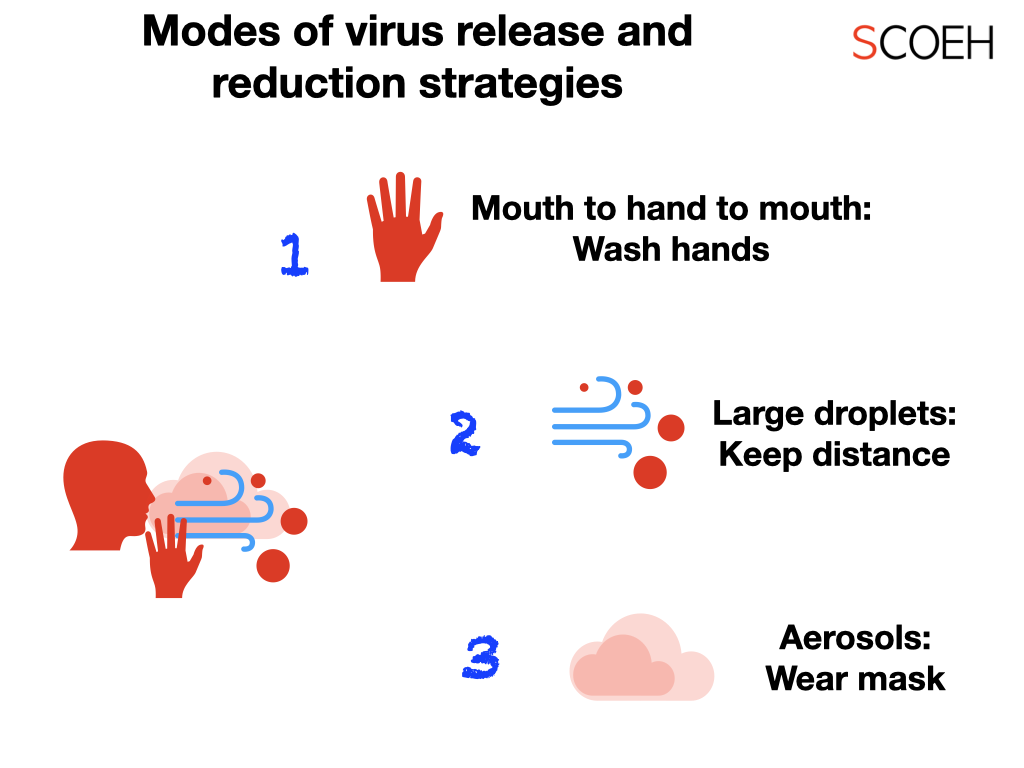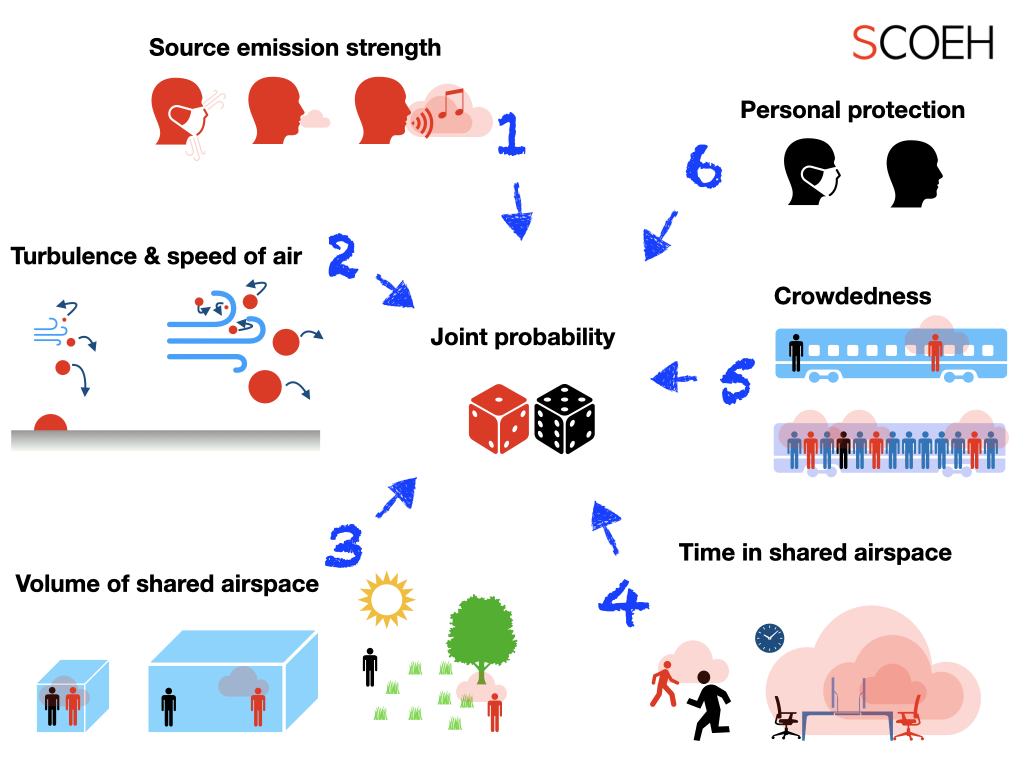When people breathe, speak or sing, they always emit small quantities of tiny lung lining fluid droplets, small enough to stay airborne for many hours. Should I worry about these aerosols? Not much if you cross others briefly on the street. Yes, if you spend a long time with others in the same room. Let me explain the basics of virus sharing, and what aerosol key factors influence the risk.
The basics – how the virus can be shared
Let’s start with the basics. The spread of the coronavirus starts when an infected cell releases new copies of the virus into the surrounding bodily liquids. If this liquid happens to be in the mouth-nose-lung region, it can be released by touching the mouth or nose with the hand; by coughing or sneezing large droplets; and by exhaling very small aerosols when breathing, speaking or singing.
To start with the conclusion, it is best to stop the spread of this hazard at the point of release. This means: wash your hands frequently, keep distance and wear a mask.

How the virus can be released as an aerosol
Your lungs provide you with fresh oxygen and get rid of carbon dioxide. For this, we inhale and exhale air. The air exchange happens in tiny sacs called alveoli. The alveoli are connected with your windpipe by a series of tubes. The tiniest of these tubes are the terminal bronchioles. These are soft tubes that collapse when they are not filled with air. Once you inhale air, they will open up again. Each time they open up, a tiny film of liquid bursts and releases a few droplets into the incoming air. When you exhale, the tiniest of these droplets are carried out and leave your lungs with your exhaled breath. Quite evidently, if your lung lining liquid contains viruses, the exhaled breath aerosol will contain them as well.
The factors influencing the risk
Do we have to be scared of these exhaled aerosols? Yes and no! The amount of virus exhaled by a normally breathing infected person is extremely small when compared to coughing, sneezing or mouth-hand-surface spreading. However, speaking and singing can strongly increase the amount of exhaled breath aerosols. Furthermore, there are some individuals described in the scientific literature as „super-emitters“, people that emit many times more aerosols than the average person. Once the aerosol is exhaled, it will stay airborne for a while and can get transported and dispersed via the air. Your risk from the „personal cloud“ of a case is also influenced by what you are doing and where you spend time. So what are the key factors deciding about your risk?

1) Source emission strength: if a case wears a mask, the emissions are much smaller than breathing, which is again much smaller than talking, singing or chanting loudly.
2) Turbulence and speed of air: in calm air, the larger aerosol droplets – those carrying the biggest load of viruses, will sediment much faster than in fast turbulent air caused e.g. by a fan.
3) Volume of shared airspace: in a tiny room, the exhaled aerosols will accumulate much faster to high levels, especially if the room is not well ventilated; while in the outdoors, the sky is the limit for ventilation.
4) Time in shared airspace: passing the personal cloud of a case on the street is a much smaller risk than spending hours in a shared office.
5) Crowdedness: this has actually two perspectives, (a) your personal perspective is that you have an increase risk to be near a case; while (b) from a public health perspective there are more people near a case (the reproductive number R0 goes up)
6) Personal protection: quite obviously, if you wear a mask, your risk goes down. Just be aware that hygiene masks do not protect well because they are emission control devices.
So here we are! Your personal risk is a combination of these factors. You can now estimate your risk by assessing whether you have a good chance to be for an extended time in a sufficiently dense personal cloud of another person.
Let me explain this with a few scenarios. Attention, when reading the scenarios, take also into account the odds of being in the personal cloud of an infected person! Unless you are a medical doctor, your personal risk is likely very low even in a high-risk scenario because there are only very few infected people. So don’t panic, just like you should not panic when you once touched your mouth without having washed your hands. Still, we all need to avoid high-risk situations because this is the best way to stop the virus from spreading. If nobody gets infected, nobody can contribute to the spread of the virus.
Low risk: walking outdoors
You will have a very low risk of getting the virus by just walking the streets and places in a city. Just make sure to wash your hands and keep distance. In this scenario, you avoid large droplet and hand-surface contaminations, and you will be passing just briefly through the „personal exhaled aerosol cloud“ of potentially infected pedestrians.
The risk is really tiny! Take for example the landfall of the cruise ship Diamond Princess in Taiwan five days before it was locked down in Yokohama, Japan due to the outbreak. At that time, about five cruise passengers were already infected with the virus. The Taiwanese authorities did a big data based tracing of Diamond Princess passengers during their tour through northern Taiwan and identified 627,386 persons who had been in proximity of any of the 3000 Diamond Princess embarked passengers. Nobody in Taiwan got sick as a result of the landfall. Even if the passengers had travelled individually on totally different routes (which is not the case), there would still have been over 10k people briefly in proximity of the five cases.
A small caveat: in Taiwan, since the beginning of the outbreak in Wuhan, almost everybody wears a hygiene mask, which will further reduce the risk even if they are not a very effective personal protective equipment.
Moderate risk: working or living in same building but on different floor
You will have a moderate risk if you work or live in the same building as an infected person, as long as you wash your hands and keep distance and don’t hang out in common spaces. The risk is slightly higher because inside buildings, the „personal cloud“ is not as well dispersed and also because it is more difficult to keep distance when crossing each other. Still, also in this scenario, you will spend only a brief time in the „personal cloud“ of another person.
A good example for this scenario an analysis of an outbreak in a call centre in a South Korean office building. Only three other people living or working on other floors of this skyscraper got infected even though they had shared the lobby and lift.
High risk: spend time with many loud speaking or singing people
You have a real chance to get infected if you spend several hours in an airspace shared with a case. The risk is not very high if the room is large, well ventilated and you are sitting far away. However, the moment you sit close together and the case speaks or sings loudly, you will have a very high risk. This is well shown by a series of events:
In a Call Center in South Korea: 94 people of a call centre got infected. In the open space office where it all started, over half of all employees got infected. But also in the other rooms on the same floor that shared the wider airspace, many people got infected.
In China, a family was gathering in a restaurant. A few days later, not only the family but also many guests on the neighbouring two tables were infected.
In Skagit Valley, WA, USA, the chorale went ahead with the rehearsal despite first cases being reported in the neighbouring Seattle city. They washed hands and kept distance, but this was not enough. A few days later, dozens had contracted the virus and two were dead.
Extreme risk: tend for patients in a COVID-19 ward
Medical personnel is highly trained to avoid infections. Despite this, across the world we saw a wave of medical staff getting sick. To understand how this can happen, I estimated the number of viruses that can be expected when a symptomatic (coughing) patient is for some time in a small room. The numbers can rapidly go into billions of virus copies per cubic-meter. At such high numbers, even N95 respirators may not be a sufficient protection! Maximal protection, such as positive pressure hoods will be much better if you have to spend extended time caring for such patients (check this BBC-report to see how this looks like in South Korea).
In conclusion
Everybody, please wash your hands regularly, keep distance from others and wear a mask whenever you are in public.
.
